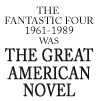







 |
 |
 |
 |
 |
 |
 |
 |
|
Stan Lee told us the secret to his success, right back at the start: |
|
| INCREDIBLE EXPLOITS |
+ | DOWN-TO-EARTH REALISM |
= | THE WORLD'S GREATEST COMIC |
Today's comic creators suggest different formulas for success:
Knowledge of the characters?
You might think that a writer needs a deep knowledge of a
characters' past. But no. Stan and Jack had an intense,
visceral understanding of the
current situation, but seldom referred to anything
more than five issues back, unless fans demanded it. Stan
would sometimes even forget a character's name (e.g. calling
Bruce Banner "Bob Banner"). As he noted in the FF 31 letters
page, the fans remembered more than he did:

Respect for a character's core? Modern editors, wishing to preserve a brand for merchandising purposes, focus on "core" characterization: what makes the character special? That is, what can be trademarked, patented, etc.? But in the best stories core characterization evolves, because the characters are like real people.
Careful planning? You
might think that a good writer needs to plan far ahead, to
weave a complex story. But as far as anyone can tell, Stan and
Jack never planned more than one issue ahead
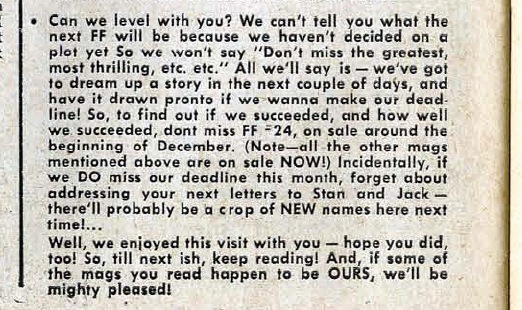
Polished art? Do great comics need realistic and classy art? Kirby's art was raw and stylized, unlike the polish of DC at the time. The DC staff were not impressed... until they saw the sales figures.
Natural dialog? Do great comics need natural dialog? Stan could write great natural dialog when he needed to, but most of the time the dialog was efficient and dense, just a tool to tell the story.
New ideas? Mark Waid said the secret was to always be new. But all of Stan and Jack's greatest innovations were old tropes: "alien threatens planet," "aliens hide among us," "bad guy repents and gives life for hero," "black chieftain in hidden city in the jungle," etc. What made them new was realism, including continuity and an awareness of current events.
By common consent, the greatest comics include Fantastic Four
44-60. These illustrate Stan Lee's formula: incredible exploits
and down to earth realism. We can break down the writing process
into very simple steps.
"That's one of the factors that made the Fantastic Four work. Quiet moments of contemplation opposite world-devouring antagonists. The ultimate man of high science working alongside one of the most down-to-earth men on the planet. The main villain vacillating between science and sorcery. Trying to have a simple, family life but also having the most fantastic powers imaginable. The book resonated with readers around these (and other) contrasting elements. The moments of high energy, excitement and drama in a book are all well and good, but only when put in relief against the slower, quieter moments. Creators shouldn't need to 'shake things up' so much as just not keep resorting to the same tropes (both with regards to story and art) all the time with nothing for readers to balance it against." - Sean Kleefeld
Finally the writer will
add the dialog: give it humor, and make sure it's easy to follow.
Job done.
Each step must follow naturally from the last. It has to be
totally believable, so you care. And you also want enough variety
so you never get bored. That means the plotter and writer need a
lot of experience! That's the skill of the great comic writer,
right there.
Does this need great planning?
No!
Notice that at no time does the writer consider anything other than the present. The writer does not plan ahead, and does not consider the past. They simply arrive with massive experience of stories in general, then immerse themselves in the present and then the story writes itself. It's simple really. The more you do this, the better the result.
Some of the best ideas just appear out of the ether, against the intentions of the writer. For example, Stan Lee did not like the idea that Galactus ate planets, he wishes he had changed it to something more subtle, but at the time he was up against a tight deadline and it was the first thing he could think of. (See "Comics Creators on Fantastic Four" page 19). He did not plan for the Silver Surfer at all - Jack Kirby thought a god-like being should have a herald, and drew him in. (At this stage Stan would give Jack just a few lines of plot, Kirby would do the rest, then Stan would add captions.)
John Byrne, the second most prolific FF writer after Stan, refers to "one of those Stan Lee moments when the characters start writing themselves." (John Byrne, "Comics Creators on Fantastic Four" page 105.)
Byrne realized it was happening with issue 236 (Byrne took over with issue 232):
"I had some distinct ideas of where I wanted the characters to go, and if you read the first couple of issues now, they don't read like themselves. That's because I was trying to put something different into them, but they ultimately told me, 'no, that's not who we are.' I sort of let go right around the time of 'Terror in a Tiny Town' and did Stan's trick of letting the characters write themselves." ( John Byrne, "Comics Creators on Fantastic Four" page 95)
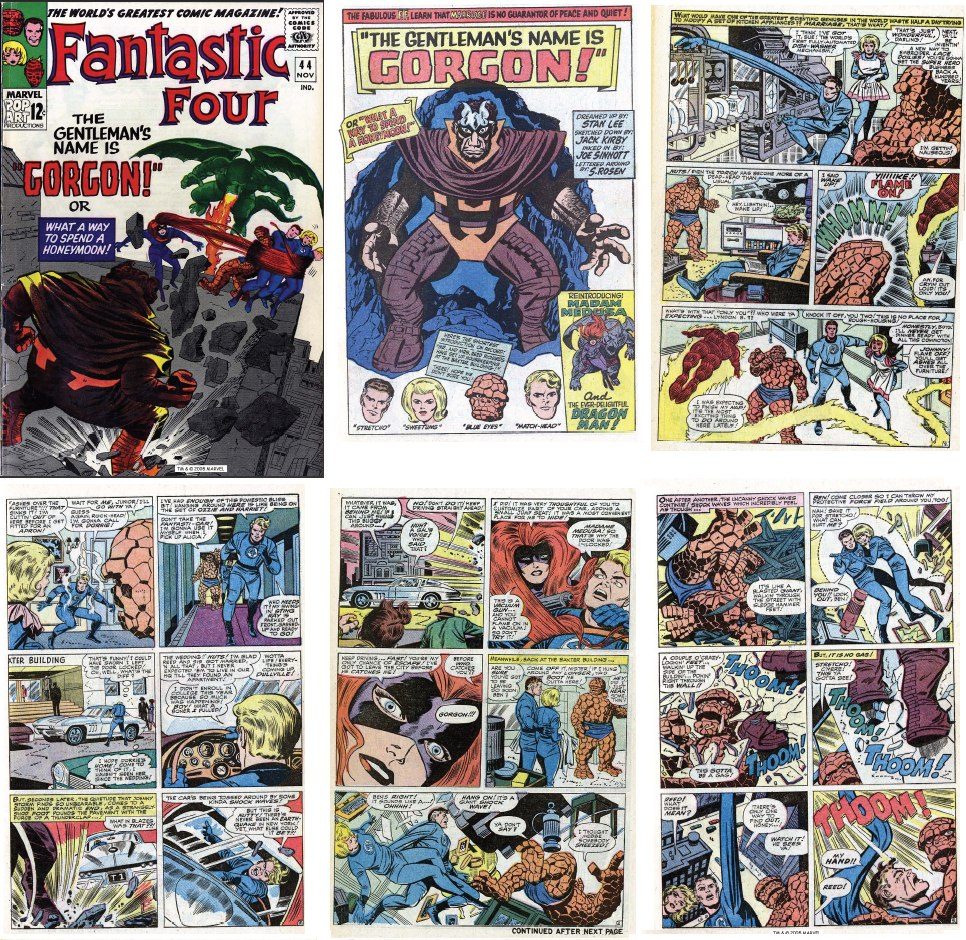
(copyright note)
For copyright reasons this web site usually shows just a few
isolated frames from each issue, not whole pages like this. These
are shrunk down to encourage you to buy the full story. If you
have even the slightest interest in story telling then you owe it
to yourself to own this issue. You can get all of these issues
really cheap in Essential Fantastic Four volume 3 (in black and
white). Go and order it now. I'll wait. OK, you now have the comic open in front of
you? Then we shall begin.
Incredible:
We start just after the previous story, the most incredible event
of all: a gigantic battle involving almost every Marvel character,
in Fantastic Four annual 3. According to the formula, after the
most incredible exploit we need to look for the most down-to-earth
realistic thing that could happen.
Down-to-earth:
The marriage is followed by the couple at home, cleaning the
house.
[ Note that the final stage in making a great comic is to add some humor and make sure it is understandable. The humor is there in Mr Fantastic inventing a vast, complicated invention that looks like a cosmic cannon mixed with an atom smasher... to wash dishes! This also serves to introduce the characters to new readers: every issue is somebody's first. So we see each character "do their thing" within the first three frames. Stan also noticed that the new character, Gorgon, might be a little confusing (we only see oddly shaped feet at first) so he adds a splash page with a clear, dramatic image of the guy. Now back to the story. ]
Incredible:
An explosion! WHOMM! Then somebody bursts into flame and flies!
Down-to-earth:
The boys get told off for making a noise and disturbing the house.
Incredible:
One of them storms off! OK, that's maybe not so incredible, but
it's dramatic, both for
new readers (this guy can burst into flames and fly, what will he
do next?) and for long time readers (we care about this family, we
hate to see them divided). Plus we are still on page 1, and still
need to establish their personalities for new readers (and remind
old readers).
[ Note how this naturally fits the pattern of Campbell's "The Hero With 1000 Faces": the hero (Johnny) needs some catalyst to make him leave his safe home, so the story can begin. This structure just comes naturally to expert story tellers like Stan Lee and Jack Kirby. Other writers would probably benefit from reading Campbell's book. The relatively tame first page also establishes a strong anchor and contrast for the crazy stuff that's about to happen, which demonstrates the realism->incredible switch on a larger scale. ]
Down-to-earth:
Johnny unlocks his car, and thinks about the wedding.
Incredible:
A giant foot suddenly stomps on the ground and the car falls over!
Now the action has really started!
[ Note that there is no need for the writer to know who this is at this point. Leaving unanswered questions provides rich fodder for future stories. All that matters is that the events make sense right now, and long term continuity will naturally arise without any effort: people will naturally be born, date, marry, grow old and die, new people will naturally appear, interact, evolve, and so on. All that matters is realism in the present, then continuity arises naturally. Contrast this with later years (especially after 1989) when realism was abandoned: characters de-aged, came back from the dead, acted out of character, etc., and long term continuity became impossible. ]
Down-to-earth:
The car is still drivable, so he turns the car round to see what
happened.
Incredible:
There is somebody hiding in the back seat!
Down-to-earth:
Meanwhile the rest of the team would have noticed the earth
shaking
Incredible:
They see somebody climb up the wall!
Down-to-earth:
Reed reaches out. The climbing being steps on his hand!
Incredible:
The climbing guy steals their helicopter!
Down-to-earth:
Go back to the person in the back seat, hey, it's somebody you
know.
Incredible:
She points a gun and hijacks the car!
Down-to-earth:
She takes the car to a forest. They walk normally in the woods.
Incredible:
Johnny would fight her with his flame of course!
Down-to-earth:
a)She kidnapped the Torch she would be prepared: knockout gas.
b) his flame warms the ground.
Incredible:
It wakes up a sleeping dragon!
Down-to-earth:
The dragon is not just one dimensional: he has feelings! He
remembers how humans hurt him, but he also remembers one woman who
was kind to him.
[ Note that this detail is the obvious
obvious to anyone who is widely read: the sympathetic dragon is an
old trope. But if your experience is only with regular comic books
then the obvious choice, what you would expect in a modern comic,
is a multi page spectacle of savagery and hell fire. However,
centuries of storytelling reveals that the more powerful story is
to give the dragon a inner conflict: a tortured soul, to give him
tragic sympathy. ]
Incredible:
just when you think you have hope, the original mystery danger,
the hunter they all fear, explosively appears!
2. Writers only need three
things:
The good writer only needs three things:
3. Occam's razor keeps the story
under control
Realism implies Occam's Razor: do not multiply elements
unnecessarily: E.g. if you have two new characters in the same
scene, then link them, as with Gorgon and Medusa, then Medusa and
Dragon Man. this both simplifies the story, and gives the reader a
structure to hold onto: it prevents the constant surprises from
becoming a confusing mess. And "incredible exploits" means the
links must be dramatic: so one person is chasing the other, or
loves another.
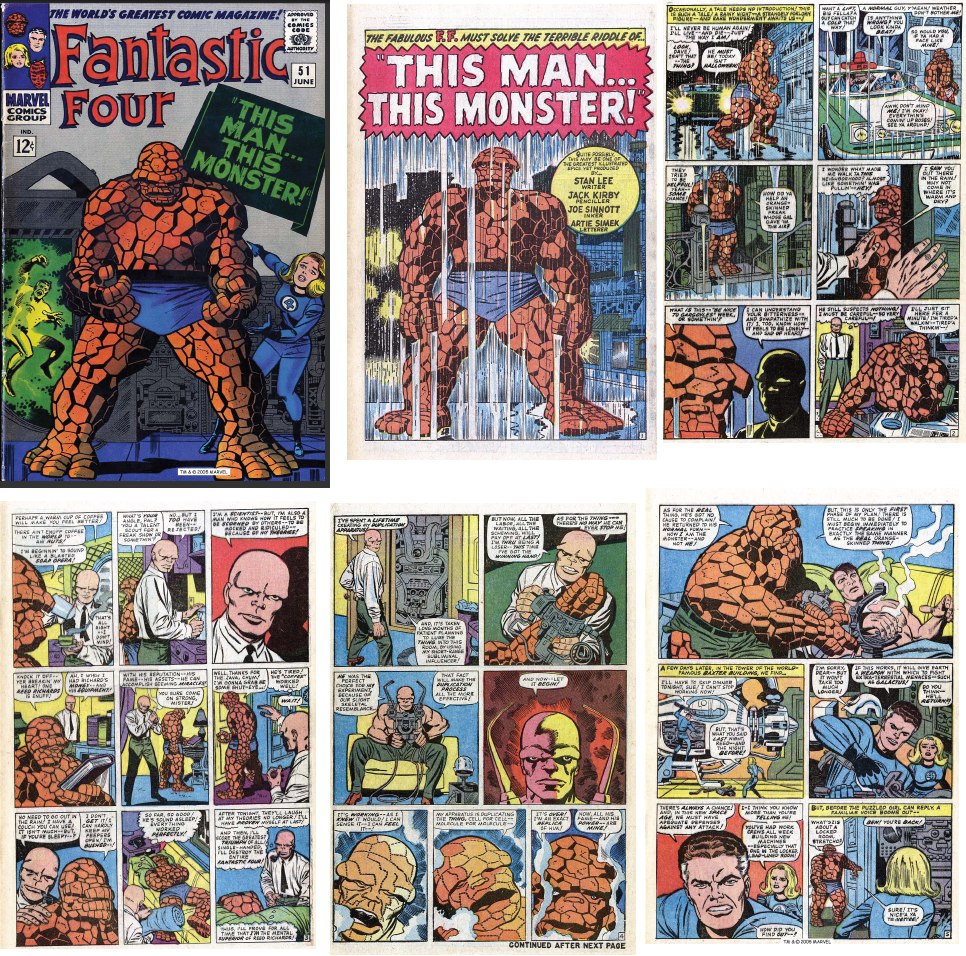
Does the realism - action - realism - action pattern only work for high action stories like FF41? What about a story based on a depressed character's feelings, like the classic FF51? FF51 was created in exactly the same way, and the incredible depth of emotion was just a natural result:
Incredible:
This story follows from defeating Galactus, and the
discovery of the silver surfer!
Down-to-earth:
At this point, after the events of Act 2, Ben Grimm has a
long term problem with self esteem. In the previous issue he saw
his girl reject him for somebody more handsome, as he always
thought she would. Only this guy is stronger than The Thing, pure
hearted and noble. How do you think Ben feels?
[ Note that Stan and Jack did not have to say "let's make a powerful emotional story," they just took the existing situation and asked what would naturally happen next? ]
Note also that you need experience of a wide variety of stories before you can make a story based on depression. There is no outward battle in this story, but a story of despair and sacrifice and mistaken death is more powerful. These tropes are well known from other stories but you won't often find them in comics.
[ Finally, note that "Ben Grimm is depressed" is only powerful because this event grows naturally from other great stories, so we care about this character. Stories about characters wandering around with depression are not normally big sellers. ]
Incredible:
Here is where story telling experience comes in. An
explosion might be more dramatic, but that would distract Ben from
his depression. A good story teller does not just drop a developed
theme, but will lead it to a satisfying conclusion. So this
incredible event has to be more subtle: some random stranger
invites Ben in off the street. It still counts as incredible
because it's not what you would expect, and makes the user wonder
"what will happen next?"
Down-to-earth:
The stranger offers Ben sympathy: he too knows what it is
to be lonely and sad..
Incredible:
He's plotting something! While Ben could win any physical
fight, an attack on his weakened emotional state is far more
dangerous!.
Down-to-earth:
The stranger just offer Ben coffee..
Incredible:
The coffee is drugged! The stranger uses a deadly looking
scientific device on Ben!
Down-to-earth:
Ben is just returned to human form. Hey, that's what he
always wanted! Now we can have stories about normal Ben!
Incredible:
Ben is asleep, so let's return to Reed and Sue: Reed is
hiding some deadly danger from Sue!
[ Note that this danger, the Negative Zone, arises naturally from the previous issue, a danger from a being who can travel faster than light. Stan and Jack did not have to think "what's the most amazing thing Reed can invent" they just ask "what would naturally happen next? Reed would try to stop any cosmic threat like Galactus appearing again. How would he do that? Try to understand how they get here." ]
Down-to-earth:
Ben shows up and says hello. But is it the real Ben or the
impostor?
And so on. The story of FF51 writes itself: it follows naturally
from the events of FF50 if we follow the formula, care for the
characters, and have experience of storytelling.
The secret behind the Fantastic Four's greatest run is a simple
formula. There is no grand plan, no analysis of the past: each
story flows naturally from the one before, as follows. Let us
start with FF44 as above.
What would naturally happen
next?
FF45: Johnny is a young man, so he needs a love interest! Occam's
razor says combine it with the "Medusa's people" plot.
What would naturally happen
next?
FF46: Now you care for one of Medusa's people, start to see thing
from their point of view.
What would naturally happen
next?
FF47: Now you know about them, why not visit their home?
What would naturally happen
next?
FF48: The story is going nowhere, so what's the most exciting
out-of-left-field thing you can think of? A giant alien comes to
eat the Earth! How to make him more exciting? Give him a huge
build up: he is feared by all the cosmic beings that we already
know, he has a herald, etc.
What would naturally happen
next?
FF49: The guy's really important, so how would he act? He'd be all
noble and god-like of course! But now you have a problem, how do
you defeat him? The only being who has close to his power is his
herald, so turn him around.
What would naturally happen
next?
FF50: He's still super unbeatable though. Aw to heck with it, use
a deus ex machina and quickly move on. What's next? Well we have a
lost cosmic guy, maybe Alicia would take pity on him like she did
Ben?
What would naturally happen
next?
FF51: Alicia's acts would make Ben depressed. And hey, that would
make him vulnerable. And we want a break from the crazy pace, so
have a small villain. And we just had a guy switch sides, it would
be neat to do it again - but what then? He's small, and the usual
ending to small stories is a noble sacrifice.
What would naturally happen
next?
FF52: That reached a natural break, so we need a new idea. Look at
the news - civil rights is big. How to make that a story? Black
people normally feature in Tarzan-lie adventures, with lost cities
and mighty warriors. But for a civil rights angle we should make
the black guy super advanced, smart and heroic.
What would naturally happen
next?
FF53: We're in the jungle: what's exciting? Wild animals and mad
white hunter. But that's no threat to the Fantastic Four, so give
them a high tech edge. What energy have we not used recently?
Solidified sound. (Not the most inspired choice, probably the
weakest of the classic issues, but still amazing, and it
illustrates the formula.)
What would naturally happen
next?
FF54: Johnny wants his true love. And she is trapped. Obviously he
will go to her. Wait, they're in Africa. So Johnny will fly over
Asia. What incredible thing could happen? Think Asian plains...
Egyptian deserts... middle east... sands cover secrets... it all
says ancient... hey, we'll do Prester John! Note that this would
not occur to most comic or sci-fi writers. but Stan and Jack have
wide interests in every genre, so they are familiar with many old
stories.
What would naturally happen
next?
FF55: By now letters are coming in, saying people love the surfer.
We left a surfer-Alicia-Thing triangle, so let's expand it into a
battle! Note that Stan and jack are not looking to past stories
for inspiration. That is the modern way, and he kiss of death for
creativity. They brought the Surfer back simply because fans
asked, and he is still fresh in their memory.
What would naturally happen
next?
FF56: There are a lot of loose ends, so let's tie them up. Klaw
has some unused potential, and Johnny is hunting Crystal, so the
rest writes itself.
What would naturally happen
next?
FF57: the surfer surfs over mountains... hey that gives me an
idea, who do we know who lives in mountains? Doctor Doom in
Latveria! What would naturally happen?
What would naturally happen
next?
FF58: Since we have the two greatest threats combined (surfer +
Doom) then we can build this up to an awesome level, with a whole
issue of rising tension, the team defeated but never giving up,
and dramatic Kirby visuals.
What would naturally happen
next?
FF59: The Inhumans sub plot has dragged on for long enough, so
what is the obvious way to resolve it? We examine the available
tools and notice that Black Bolt's voice will do the job. As for
Doom, we haven't dropped in on the surfer for a while so should do
so.
[ Note that once again a wide knowledge of stories is needed. Just dropping by on the surfer is not dramatic, until we remember stories like The Prisoner of Zenda or the Man in the Iron Mask: this now becomes a good opportunity for drama and pathos between evil usurper and noble prisoner in a filthy stone cell. ]
What would naturally happen
next?
FF60: the Doom saga has also gone on lone enough: tie for a
dramatic big battle ending. The solution arises naturally from
examining the characters: one is trapped on Earth and the other
has unlimited arrogance.
And so on. Each story arises naturally from the one before: a natural result of realism plus choosing the most incredible option each time.
After 1968 less effort went into each issue, with the result that the pace of change slowed down. More seriously, fear of change and the stretching timescale ate away at realism. The story still progressed, but at a slower pace and more effort was required to extract the gold.
John Byrne gave the title a sales boost, and this is usually attributed to going back to how the characters were in the early days. However, Byrne's characters were nothing like the early days: his Reed had lost confidence, his Sue was more assertive, his Ben was no longer in conflict with Reed, and of course Franklin was around. The big difference was that Byrne increased the quota of "down to earth realism." His team were often see outside in ordinary streets, they wore wrinkled clothing, dealt more often with ordinary people, and so on.
In general though, nobody could combine the ordinary with the amazing like Jack Kirby, and the pace of change was slower after 1968 so sales were lower. Then in 1989 realism took another hit as long term character development ended, realism became a low priority (see Sue's costume for example), and stories were all variations on old comics rather than being drawn from literature and the real world.
Perhaps the boldest example of what not to do was Heroes Reborn: whatever its claims to "incredible exploits," "down-to-earth realism" was abandoned completely.
Some later writers injected a little realism: Waid, for example,
showed Sue and Ben taking Franklin to Coney Island and his
Latveria seemed down to earth, but mainly the team was divorced
from the reader's reality. Hickman's FF for example, while
generally praised for intelligent writing and sensitive character
portrayals, features a polished team of wealthy professionals, who
spend most of their lives talking, and very seldom interact with
any world that the readers would recognize. The Marvel Knights
series was an attempt to increase the level of realism, but was
only slightly better: it was good to see Reed and Sue driving a
normal car, but they still sent their son to a private school with
a humanoid robot companion. "Down-to-earth realism" only goes so
far. Coupled with the lack of a long term story and high priced
decompressed stories, the bang per buck of the average comic is
too low to compete with other media, and the long term literary
value is even lower.
One approach to writing is to ignore the formula (which asks "where are the characters right now") and instead ask where they should be. In other words, the editor has some idea of the "defining element" or "core characteristic" of a character and works from that. For example:
Q. "Do
you have a greater responsibility to your creative team or to
the characters?"
A. "To the characters. Always
the characters! They're the Bread and Butter of Marvel Comics.
The characters are the most important thing we have. Each
character has certain core characteristics. If a writer wants to
come in and ignore or violate those characteristics, it's the
editor's job to stop him or her."
- Ralph Macchio, "Comics Creators on Fantastic Four" page 177.
There are several problems with this position.
"Most of the best comic book series are about something--something that may not factor into every single last adventure, but which is the underpinning of the series as a whole. Fantastic Four is about family. X-Men is about prejudice. Batman is about revenge. And Spider-Man is about youth. Youth is the element that defined Spider-Man back in the days when he was created, the thing that separated him from all of the other competing superhuman crime-fighters and made him unique."
And yet...
To simply say the Fantastic Four is "about family" is very dangerous. It leads to terrible stories. It implies that Ben, once the greatest fighter of all and a tragic hero, should live as either a man-child or a kindly uncle. It further implies that their lives revolve around having dinner together. Those are precisely the two weaknesses that have destroyed the title since 1989.
Characters must be allowed to grow naturally, so the "defining element" is the enemy of the great story.
The formula for success is realism, and this means character development. Here are three examples:
In the early days the Thing was defined by his anger. This changed, and the anger was replaced with being depressed. This led to the classic FF51, "This Man his Monster."
The original team had a love triangle between Ben, Sue and Reed (in issue 1). Later this dynamic changed when Ben met Alicia. Without Alicia the Silver Surfer would not have decided to stay on Earth.
In the original team, Reed and Sue were unmarried. This changed, allowing all the team members to live full time in the Baxter Building, and all the classic issues followed. It also allowed the birth of Franklin, the Crystal issues, and meeting Annihilus (annual 6).
The fans noticed these fundamental changes and it made them care. This is from issue 99, ear the end of Stan and Jack's historic run:
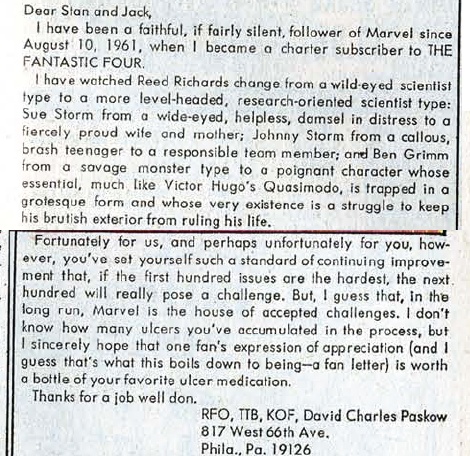
Deep change is essential if we are to deeply care. Novels pretty much demand change to a character's defining features. The hero must change: Scrooge must repent, Jean Valjean must cease hating the world, Edmund Dantes must grow cynical, and then finally become wise. Elizabeth Bennett must lose her prejudice.
If we follow the formula for great comics then change like this change comes naturally. It's not rocket science.
.